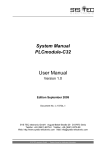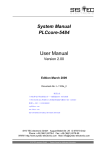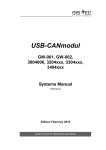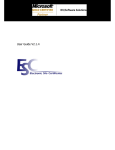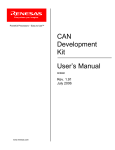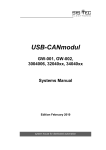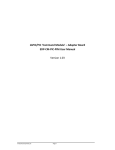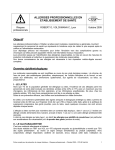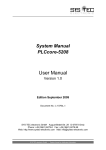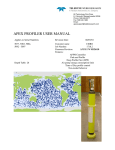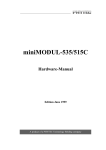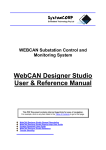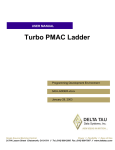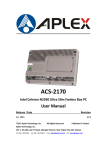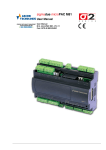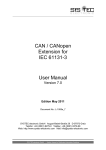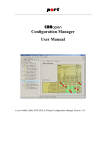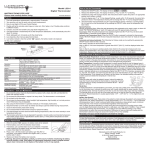Download L-1515, System Manual PLCcore-F407
Transcript
System Manual PLCcore-F407 User Manual Version 4 Edition June 2015 Document No.: L1515_4 SYS TEC electronic GmbH Am Windrad 2 D-08468 Heinsdorfergrund Telefon: +49 (3765) 38600-0 Telefax: +49 (3765) 38600-4100 Web: http://www.systec-electronic.com Mail: [email protected] Status/Changes SYS TEC electronic GmbH - System House for distributed Automation System Manual PLCcore-F407 Status: released Date/Version 2014/01/28 Version 1 2014/02/20 Section Changes Editor All Creation T. Volckmann Figures Updated figures to the latest core and baseboard revision T. Volckmann Table 12 Add column for pull up/down mapping 2014/02/24 Section 7.5.2 Add frequency for PWM output T. Volckmann Add frequency for Counter input 2014/04/10 Table 32 Add reference for using NVDATA function blocks T. Volckmann 2014/07/23 Version 2 Section 7.7.2 Add note regarding CAN1 interface T. Volckmann 2014/08/04 Section 3 Amplitude information for PWM output T. Volckmann 2014/09/19 Appendix A Add mapping for SIO PORT parameters T. Volckmann Section 7.3.2 Add how to interpret current measurement Section 9 Add jumper configuration 2015/02/10 Version 3 Section 7.3.2 Corrected current consumption 2015/06/08 Version 4 Figure 16 Corrected description of Figure 16 Section 7.8.1 Reworked parameter description for SIO Function Blocks Table 7 Add IO Timings 2014/09/22 © SYS TEC electronic GmbH 2015 L1515_4 T. Volckmann T. Volckmann T. Volckmann Page 2 System Manual PLCcore-F407 This manual includes descriptions for copyrighted products that are not explicitly indicated as such. The absence of the trademark () symbol does not infer that a product is not protected. Additionally, registered patents and trademarks are similarly not expressly indicated in this manual. The information in this document has been carefully checked and is believed to be entirely reliable. However, SYS TEC electronic GmbH assumes no responsibility for any inaccuracies. SYS TEC electronic GmbH neither guarantees nor accepts any liability whatsoever for consequential damages resulting from the use of this manual or its associated product. SYS TEC electronic GmbH reserves the right to alter the information contained herein without prior notification and does not accept responsibility for any damages which might result. Additionally, SYS TEC electronic GmbH neither guarantees nor assumes any liability for damages arising from the improper usage or improper installation of the hardware or software. SYS TEC electronic GmbH further reserves the right to alter the layout and/or design of the hardware without prior notification and accepts no liability for doing so. Copyright 2015 SYS TEC electronic GmbH. All rights – including those of translation, reprint, broadcast, photomechanical or similar reproduction and storage or processing in computer systems, in whole or in part – are reserved. No reproduction may occur without the express written consent from SYS TEC electronic GmbH. Inform yourselves: Contact Direct Address: SYS TEC electronic GmbH Am Windrad 2 D-08468 Heinsdorfergrund GERMANY Ordering Information: +49 (0) 37 65 / 38 600-0 [email protected] Technical Support: +49 (0) 37 65 / 38 600-0 [email protected] Fax: +49 (0) 37 65 / 38 600-4100 Web Site: http://www.systec-electronic.com Your local distributor Please find a list of our distributors under: http://www.systecelectronic.com/distributors 4th Edition June 2015 © SYS TEC electronic GmbH 2015 L1515_4 Page 3 System Manual PLCcore-F407 Table of Contents 1 Introduction ................................................................................................................... 6 2 Overview / Where to find what? .................................................................................... 7 3 Product Description ...................................................................................................... 9 4 Development Kit PLCcore-F407 ................................................................................. 11 4.1 4.2 4.3 4.4 5 Overview .............................................................................................................................. 11 Electric commissioning of the Development Kit PLCcore-F407 .......................................... 12 Control elements of the Development Kit PLCcore-F407 ................................................... 13 Optional accessory .............................................................................................................. 14 4.4.1 USB-RS232 Adapter Cable .................................................................................... 14 Electrical characteristic of the PLCcore-F407 ........................................................... 15 5.1 5.2 5.3 General operating conditions............................................................................................... 15 I/O characteristic .................................................................................................................. 15 Ethernet characteristics ....................................................................................................... 16 6 Pinout of the PLCcore-F407 ........................................................................................ 18 7 PLC Functionality of the PLCcore-F407 ..................................................................... 22 7.1 7.2 7.3 7.4 7.5 7.6 7.7 7.8 System start of the PLCcore-F407 ...................................................................................... 22 Programming the PLCcore-F407......................................................................................... 22 Process image of the PLCcore-F407 .................................................................................. 23 7.3.1 Local In- and Outputs ............................................................................................. 23 7.3.2 Calculate current measurement.............................................................................. 24 7.3.3 In- and outputs of user-specific baseboards........................................................... 24 Communication interfaces ................................................................................................... 25 7.4.1 Serial interfaces ...................................................................................................... 25 7.4.2 CAN interfaces ........................................................................................................ 25 7.4.3 Ethernet interfaces .................................................................................................. 25 Specific peripheral interfaces .............................................................................................. 25 7.5.1 Counter inputs ........................................................................................................ 25 7.5.2 Pulse outputs .......................................................................................................... 26 Control and display elements .............................................................................................. 27 7.6.1 Run-LED (green) .................................................................................................... 27 7.6.2 Error-LED (red) ....................................................................................................... 27 Using CANopen for CAN interfaces .................................................................................... 28 7.7.1 CAN interface CAN0 ............................................................................................... 29 7.7.2 CAN interface CAN1 ............................................................................................... 29 Controller specific PLC Function Blocks ............................................................................. 32 7.8.1 The Function Blocks SIO_*..................................................................................... 32 8 Updating the PLCcore-F407 Firmware ....................................................................... 33 9 Baseboard Configuration ............................................................................................ 35 9.1 9.2 9.3 General Jumpers ................................................................................................................. 35 Serial Output ........................................................................................................................ 36 Control Area Network .......................................................................................................... 38 10 OpenPCS Programming System ................................................................................ 39 10.1 10.2 10.3 10.4 Installation Driver for USB-CANmodul ................................................................................ 39 Installation OpenPCS Programming System ...................................................................... 39 Define Network Connection ................................................................................................. 41 Assign Network Connection to Resource ............................................................................ 43 © SYS TEC electronic GmbH 2015 L1515_4 Page 4 System Manual PLCcore-F407 11 Configuration Command Shell ................................................................................... 45 11.1 Entering the Configuration Command Shell ........................................................................ 45 11.2 Command Description ......................................................................................................... 47 11.2.1 GET_DEV_CONFIG ............................................................................................... 47 11.2.2 SET_IP_CONFIG ................................................................................................... 48 11.2.3 SET_CAN_CONFIG ............................................................................................... 48 11.2.4 SET_CAN_ERRLEV ............................................................................................... 49 11.2.5 SET_WDG_MODE ................................................................................................. 50 11.2.6 SET_SSDWL_MODE ............................................................................................. 50 11.2.7 SET_CRC_MODE .................................................................................................. 51 11.2.8 GET_LAST_ERROR .............................................................................................. 51 11.2.9 PRINT_CFG_FILE .................................................................................................. 52 11.2.10 DEL_CFG_FILE ...................................................................................................... 52 11.2.11 DEL_PLC_PROG ................................................................................................... 52 11.2.12 DEL_NVDATA ........................................................................................................ 53 11.2.13 DIR .......................................................................................................................... 53 11.2.14 DUMP_FILE ............................................................................................................ 53 11.2.15 DEL_FILE ............................................................................................................... 54 11.2.16 FORMAT_FS .......................................................................................................... 54 11.2.17 EXIT ........................................................................................................................ 55 11.2.18 HELP....................................................................................................................... 55 Index.................................................................................................................................... 59 © SYS TEC electronic GmbH 2015 L1515_4 Page 5 System Manual PLCcore-F407 1 Introduction Thank you that you have decided for the SYS TEC PLCcore-F407. This product provides to you an innovative and high-capacity PLC-kernel. Due to its high performance on a small manufactured size and due to its low power consumption, it is well-suitable as communication and control processor for embedded applications. Please take some time to read through this manual carefully. It contains important information about the commissioning, configuration and programming of the PLCcore-F407. It will assist you in getting familiar with the functional range and usage of the PLCcore-F407. This document is complemented by other manuals, e.g. for the OpenPCS IEC 61131 programming system and the CANopen extension for IEC 61131-3. Table 1 in section 2 shows a listing of relevant manuals for the PLCcore-F407. Please also refer to those complementary documents. For more information, optional products, updates et cetera, we recommend you to visit our website: http://www.systec-electronic.com. The content of this website is updated periodically and provides to you downloads of the latest software releases and manual versions. Declaration of Electro Magnetic Conformity for PLCcore-F407 (EMC law) The PLCcore-F407 has been designed to be used as vendor part for the integration into devices (further industrial processing) or as Development Board for laboratory development (hard- and software development). After the integration into a device or when changes/extensions are made to this product, the conformity to EMC-law again must be assessed and certified. Only thereafter products may be launched onto the market. The CE-conformity is only valid for the application area described in this document and only under compliance with the following commissioning instructions! The PLCcore-F407 is ESD-sensitive and may only be unpacked, used and operated by trained personal at ESD-conform work stations. The PLCcore-F407 is a module for the application in automation technology. It features IEC 61131-3 programmability, uses standard CAN-bus and Ethernet network interfaces and a standardized network protocol. Consequently, development times are short and hardware costs are reasonable. PLCfunctionality is created on-board through a CANopen network layer. Hence, it is not necessary for the user to create firmware. © SYS TEC electronic GmbH 2015 L1515_4 Page 6 System Manual PLCcore-F407 2 Overview / Where to find what? The PLCcore-F407 is based on SYS TEC ECUcore-F407 hardware and is extended by PLC-specific functionality (PLD software, PLC firmware). There are different hardware manuals for all hardware components such as the ECUcore-F407 and the PLCcore-F407 (the hardware of both modules is identical), development boards and reference circuitry. Software-sided, the PLCcore-F407 is programmed with IEC 61131-3-conform OpenPCS programming environment. There are additional manuals for OpenPCS that describe the handling of programming tools and SYS TEC-specific extensions. Those are part of the software package "OpenPCS". Table 1 lists up all relevant manuals for the PLCcore-F407. Table 1: Overview of relevant manuals for the PLCcore-F407 Information about… In which manual? Basic information about the PLCcore-F407 (configuration, administration, process image, connection assignment, firmware update, hardware description et cetera) In this manual Basics about the OpenPCS IEC 61131 programming system Brief instructions for the programming system (Entry "OpenPCS Documentation" in the OpenPCS program group of the start menu) (Manual no.: L-1005) Complete description of the OpenPCS IEC 61131 programming system, basics about the PLC programming according to IEC 61131-3 Online help about the OpenPCS programming system Command overview and description of standard function blocks according to IEC 61131-3 Online help about the OpenPCS programming system SYS TEC extension for IEC 61131-3: - String functions - UDP function blocks - SIO function blocks - FB for RTC, Counter, PWM/PTO User Manual "SYS TEC-specific extensions for OpenPCS / IEC 61131-3" (Manual no.: L-1054) CANopen extension for IEC 61131-3 (Network variables, CANopen function blocks) User Manual "CANopen extension for IEC 61131-3" (Manual no.: L-1008) Textbook about PLC programming according to IEC 61131-3 IEC 61131-3: Programming Industrial Automation Systems John/Tiegelkamp Springer-Verlag ISBN: 3-540-67752-6 (a short version is available as PDF on the OpenPCS installation CD) © SYS TEC electronic GmbH 2015 L1515_4 Page 7 System Manual PLCcore-F407 Section 4 of this manual explains the commissioning of the PLCcore-F407 based on the Development Kit for the PLCcore-F407 and their electrical characteristics. Section 6 describes the connection assignment of the PLCcore-F407. Section 0 explains details about the application of the PLCcore-F407, e.g. the setup of the process image, the meaning of control elements and it provides basic information about programming the module. Moreover, information is given about the usage of CAN interfaces in connection with CANopen. Section 8 describes the firmware update process of the PLCcore-F407. Section 9 explains the baseboard configuration of the PLCcore-F407 Development Kit. Section 10 shows how to install and configure the OpenPCS environment for the PLCcoreF407. Section 11 explains the configuration command shell and the available commands. This section not only includes the command names itself, but also their parameters and shows some example configurations. © SYS TEC electronic GmbH 2015 L1515_4 Page 8 System Manual PLCcore-F407 3 Product Description The PLCcore-F407 as another innovative product extends the SYS TEC electronic GmbH product range within the field of control applications. In the form of an insert-ready core module, it provides to the user a complete and compact PLC. Due to CAN and Ethernet interfaces, the PLCcore-F407 is best suitable to perform decentralized control tasks. Figure 1: Top view of the PLCcore-F407 These are some significant features of the PLCcore-F407: High-performance CPU kernel (ARM 32-bit Cortex-M4, 168 MHz CPU Clock, 210 DMIPS) 192 KByte SDRAM Memory, 1 MByte FLASH Memory 2x52 pin card edge (Mini PCie connector footprint) 1x 10/100 Mbps Ethernet LAN interface (with on–board PHY) 2x CAN 2.0B interface, usable as CANopen Manager (CiA 302-conform) 3x synchronous/asynchronous serial ports (USART) 24 digital inputs (2 of these are usable as high-speed counter with 1 direction and 1 input each) 22 digital outputs (2 of these are usable as PWM/PTO output with pulse/dir) 8 analog inputs 2 analog outputs On-board peripherals: - RTC - Temperature sensor Programmable in IEC 61131-3 Function block libraries for communication (CANopen, Ethernet and UART/USART) Function block libraries for hardware components (RTC, Counter, PWM/PTO) Support of typical PLC control elements (e.g. Run-LED, Error-LED) Small dimension (67.5x52.5 mm) There are different types of firmware available for the PLCcore-F407. They differ regarding the protocol used for the communication between Programming PC and PLCcore-F407: © SYS TEC electronic GmbH 2015 L1515_4 Page 9 System Manual PLCcore-F407 Order number: 3390094: PLCcore-F407/Z4 (CANopen) communication with Programming PC via CANopen Protocol (Interface CAN0) Order number: 3390095: PLCcore-F407/Z5 (Ethernet) communication with Programming PC via UDP Protocol (Interface ETH0) Making PLC available as an insert-ready core module with small dimensions reduces effort and costs significantly for the development of user-specific controls. The PLCcore-F407 is also very well suitable as intelligent network node for decentralized processing of process signals (CANopen and UDP). Additionally, it can be used as basic component for special assemblies or as PLC in hard-to-access areas. The on-board firmware of the PLCcore-F407 contains the entire PLC runtime environment including CANopen connection with CANopen master functionality. Thus, the module is able to perform control tasks such as linking in- and outputs or converting rule algorithms. Data and occurrences can be exchanged with other nodes (e.g. superior main controller, I/O slaves and so forth) via CANopen network, Ethernet (UDP protocol) and serial interfaces (UART). Moreover, the number of in- and outputs either is locally extendable or decentralized via CANopen devices. For this purpose, the CANopen-Chip is suitable. It has also been designed as insert-ready core module for the appliance in user-specific applications. The PLCcore-F407 provides 24 digital inputs (DI0...DI23, 3.3V level), 22 digital outputs (DO0...DO21, 3.3V level), 2 high-speed counter input (with 1 direction and 1 input each) and 2 PWM output (3,3V amplitude). This default I/O configuration can be adapted for specific application requirements by SYS TEC (please contact [email protected] if you are interested in this option). Saving the PLC program in the on-board Flash-Disk of the module allows an automatic restart in case of power breakdown. Programming the PLCcore-F407 takes place according to IEC 61131-3 using the OpenPCS programming system of the company infoteam Software GmbH (http://www.infoteam.de). This programming system has been extended and adjusted for the PLCcore-F407 by the company SYS TEC electronic GmbH. Hence, it is possible to program the PLCcore-F407 graphically in KOP/FUB, AS and CFC or textually in AWL or ST. Downloading the PLC program onto the module takes place via Ethernet or CANopen – depending on the firmware that is used. Addressing in- and outputs and creating a process image follows the SYS TEC scheme for compact control units. Like all other SYS TEC controls, the PLCcore-F407 supports backward documentation of the PLC program as well as the debug functionality including watching and setting variables, single cycles, breakpoints and single steps. © SYS TEC electronic GmbH 2015 L1515_4 Page 10 System Manual PLCcore-F407 4 Development Kit PLCcore-F407 4.1 Overview The Development Kit PLCcore-F407 is a high-capacity, complete package at a particularly favorable price. Based on a compact PLC, it enables the user to perform decentralized, network-compatible automation projects. Moreover, it facilitates the user to get to know the advantages of graphical and textual PLC programming according to IEC 61131-3 – compared to conventional programming languages. Figure 2: Development Kit PLCcore-F407 The Development Kit PLCcore-F407 ensures quick and problem-free commissioning of the PLCcoreF407. Therefore, it combines all hard- and software components that are necessary to create own applications: the core module PLCcore-F407, the corresponding Development Board containing I/O periphery and numerous interfaces, the OpenPCS IEC 61131 programming system as well as further accessory. Thus, the Development Kit forms the ideal platform for developing user-specific applications based on the PLCcore-F407. It allows for a cost-efficient introduction into the world of decentralized automation technology. All components included in the Kit enable in- and output extensions of the PLCcore-F407 through CANopen-I/O-assemblies. Thus, the Development Kit may also be used for projects that require PLC with network connection. The Development Kit PLCcore-F407 contains the following hardware components: PLCcore-F407 Development Board for the PLCcore-F407 USB cable CD with programming software, examples, documentation and other tools The Development Board included in the Kit facilitates quick commissioning of the PLCcore-F407 and simplifies the design of prototypes for user-specific applications based on this module. Among other equipment, the Development Board comprises different power supply possibilities, Ethernet interface, © SYS TEC electronic GmbH 2015 L1515_4 Page 11 System Manual PLCcore-F407 CAN interface, 4 push buttons and 4 LED as control elements for digital in- and outputs and it comprises a potentiometer for the analog input. Signals that are available from plug connectors of the PLCcore-F407 are linked to pin header connectors and enable easy connection of own peripheral circuitry. Hence, the Development Board forms an ideal experimentation and testing platform for the PLCcore-F407. The OpenPCS IEC 61131 programming system included in the Kit serves as software development platform and as debug environment for the PLCcore-F407. Thus, the module can either be programmed graphically in KOP/FUB, AS and CFC or textually in AWL or ST. Downloading the PLC program onto the module takes place via Ethernet or CANopen – depending on the firmware that is used. High-capacity debug functionality such as watching and setting variables, single cycles, breakpoints and single steps simplify the development and commissioning of user software for this module. 4.2 Electric commissioning of the Development Kit PLCcore-F407 The Development Kit PLCcore-F407 can be simply powered via USB (P200). An external power adapter is only required for running the Development Kit PLCcore-F407 stand alone, without connection to a Host PC. An USB cable is already included in the Kit delivery. For commissioning the Kit, it is essential to use at least USB (P200, for power supply and configuration via virtual serial interface, see section 11) and – depending on the firmware version – either ETH0 (X200, for order number 3390095) or CAN0 (P201A, for order number 3390094). Table 2 provides an overview over the connections of the Development Kit PLCcore-F407. Table 2: Connections of the Development Kit PLCcore-F407 Connection Labeling on the Development Board Remark USB (Power supply and COM0/RS232) P200 USB is used for: - Power supply and - Serial connection to run configuration shell (e.g. setting CAN and IP configuration, see section 11) Alternative Power Supply X101 or X102 An external power supply (5..24V) can be used optionally for running the Development Kit PLCcoreF407 stand alone, without connection to a Host PC. ETH0 (Ethernet) X200 This interface serves as communication interface with the Programming PC and is necessary for the program download (PLCcore-F407/Z5, order number 3390095), besides can be used freely for the user program. CAN0 (CAN) P201A This interface serves as communication interface with the Programming PC and is necessary for the program download (PLCcore-F407/Z4, order number 3390094), besides can be used freely for the user program. COM1 (RS485) P201B This interface can be used freely for general operation of the user program. COM2 (RS232) P201B This interface can be used freely for general operation of the user program. © SYS TEC electronic GmbH 2015 L1515_4 Page 12 System Manual PLCcore-F407 Figure 3 shows the positioning of the most important connections of the Development Board for the PLCcore-F407. Figure 3: Positioning of most important connections on the Development Board for the PLCcore-F407 Advice Upon commissioning, cables for Ethernet (ETH0 / X200) and RS232 (COM0 / P201B) must be connected prior to activating the power supply (USB / P200 or external power supply via X101 / X102). 4.3 Control elements of the Development Kit PLCcore-F407 The Development Kit PLCcore-F407 allows for easy commissioning of the PLCcore-F407. It has available various control elements to configure the module and to simulate in- and outputs for the usage of the PLCcore-F407 as PLC kernel. In Table 3 control elements of the Development Board are listed and their meaning is described. © SYS TEC electronic GmbH 2015 L1515_4 Page 13 System Manual PLCcore-F407 Table 3: Control elements of the Development Board for the PLCcore-F407 Control element Name Meaning Pushbutton 0 SW0 Digital Input DI0 (Process Image: %IX0.0) Pushbutton 1 SW1 Digital Input DI1 (Process Image: %IX0.1) Pushbutton 2 SW2 Digital Input DI2 (Process Image: %IX0.2) Pushbutton 3 SW3 Digital Input DI3 (Process Image: %IX0.3) LED 0 LED0 Digital Output DO0 (Process Image: %QX0.0) LED 1 LED1 Digital Output DO1 (Process Image: %QX0.1) LED 2 LED2 Digital Output DO2 (Process Image: %QX0.2) LED 3 LED3 Digital Output DO3 (Process Image: %QX0.3) Poti (ADC) AIN Analog Input AI0 (Process Image: %IW8.0) Run-LED RUN Display of activity state of the PLC (see section 7.6.1) Error-LED ERROR Display of error state of the PLC (see section 7.6.2) 4.4 Optional accessory 4.4.1 USB-RS232 Adapter Cable The SYS TEC USB-RS232 Adapter Cable (order number 3234000) provides a RS232 interface via an USB-Port of the PC. Together with a terminal program, it enables the configuration of the PLCcoreF407 from PCs, e.g. laptop computers which do not have RS232 interfaces any more. Figure 4: SYS TEC USB-RS232 Adapter Cable © SYS TEC electronic GmbH 2015 L1515_4 Page 14 System Manual PLCcore-F407 5 Electrical characteristic of the PLCcore-F407 5.1 General operating conditions The following table shows the general operating conditions together with their respective operating range of the PLCcore-F407. Table 4: General operating conditions Symbol Parameter Min Typ Max Unit 3V3 Standard operating voltage 3V3 3,135 3,300 3,465 V I3V3 Total current consumption 3V3-Domain - 250,000 450,000 mA VREF Reference voltage (3V3-VREF < 1.2V!) 1,800 - IVREF VREF DC current consumption - 300,000 500,000 µA VBAT Backup operating voltage (internal, external RTC) 1,800 - 3,600 V IVBAT Backup domain supply current - - TBD µA TA Operating Temperature Range -40,000 - 85,000 °C 3V3 V 5.2 I/O characteristic The tables below show the most important characteristics of analog and digital in- and outputs. Table 5: Analog input characteristic Symbol Parameter Min Typ Max Unit VAIN Conversion voltage range 0 - VREF V RAIN External input impedance - - 50 kΩ CADC Internal sample and hold capacitor - - 4 pF Table 6: Analog output characteristic Symbol Parameter Min Typ Max Unit DAC_OUT min Lower DAC_OUT voltage with buffer OFF - 0,5 - mV DAC_OUT min Higher DAC_OUT voltage with buffer OFF - - VREF1LSB V RO Impedance output with buffer OFF - - 15 kΩ CLOAD Capacitive load - - 50,000 pF © SYS TEC electronic GmbH 2015 L1515_4 Page 15 System Manual PLCcore-F407 Table 7: Digital input characteristic Symbol Parameter Min Typ Max VIL Input low level voltage GND-0,3 0 0,3 x 3V3 V VIH FT I/O input high level voltage 0,7 x 3V3 3,300 5,200 V VIH TC I/O input high level voltage 0,7 x 3V3 3,300 3,600 V Vhys IO FT Schmitt trigger voltage mV hysteresis 0,05 x 3V3 V Ilkg I/O FT input leakage current - CIO I/O pin capacitance - tf(IO)out Output high to low level fall time and output low to thigh level rise time for CL=10 pF - Unit 3,000 µA 5,000 pF 2.5 ns Table 8: Digital output characteristic Symbol Parameter Min Typ Max Unit VOL Output low level voltage for an I/O pin when 8 pins are sunk at same time (IIO=8mA) - - 0,4 V VOH Output high level voltage for an I/O pin when 8 pins are sourced at same time 2,40 - - V IIO Output current sunk/source by any I/O pin - - 25 mA IIOmaxsource The maximum sum of IIO sourced by the device - - 150,000 mA IIOmaxsource The maximum sum of IIO sunk by the device - 150,000 mA - 5.3 Ethernet characteristics In the table below you will find important information about the Ethernet characteristics of the PLCcore-F407. Table 9: Ethernet receive or transmit signal characteristic Symbol Parameter Min Typ Max Unit VIHETH Input high level voltage 2 - - V VILETH Input low level voltage - - 0,8 V VOHETH Output high level voltage 2,40 - VOLETH Output low level voltage - - 0,4 V IINETH Input Current - -10 10 µA |Ioz| Output Tri-State Leakage - - 10 µA © SYS TEC electronic GmbH 2015 L1515_4 V Page 16 System Manual PLCcore-F407 Table 10: Ethernet LED output characteristic Symbol Parameter Min Typ Max Unit ILED LED output drive current - 8 - mA © SYS TEC electronic GmbH 2015 L1515_4 Page 17 System Manual PLCcore-F407 6 Pinout of the PLCcore-F407 The PLCcore-F407 provides board I/O functionalities through simple connector footprint using two pin card edge connectors (X301 and X303, see Figure 6). Appropriate pin header connectors corresponding to the PLCcore-F407 are available from company “Tyco” and “JAE”: Tyco name: Tyco order number: 56 pol Mini PCIexpress Connector 1717831 JAE name: JAE order number: 56 pol Mini PCIexpress Connector MM60-52B1-E1-R650 It is also recommended to use spacers to fix the module onto the baseboard. They are also available from company “JAE”: JAE name: JAE order number: Spacer NT4R1600 Figure 5: Footprint of the PLCcore-F407 © SYS TEC electronic GmbH 2015 L1515_4 Page 18 System Manual PLCcore-F407 Figure 6: Pinout of the PLCcore-F407 - top view Figure 6 exemplifies the position of the pin card edge connectors (X200 and X201) on the PLCcoreF407. The figure below shows the mapping between the connectors of the ECUcore-F407 and the Development Kit PLCcore-F407. Core-Modul PLCcore-F407 X200 X201 X301 X303 Baseboard PLCcore-F407 Figure 7: Connector Mapping between PLCcoreF407 and ECUcore-F407 A complete connection assignment of this module is listed up in Table 11. Table 11: Connections of the PLCcore-F407, completely, sorted by connection pin Signal Pin Pin Signal Signal Pin Pin Signal +3V3_Core X301/1 X301/2 SIO1 +3_3V_Core X303/1 X303/2 CNT0 GND X301/3 X301/4 SIO1 GND- X303/3 X303/4 CNT0_DIR ETH_RXP X301/5 X301/6 /RUN-LED JTMS X303/5 X303/6 CNT1 ETH_RXM X301/7 X301/8 /ERROR-LED JTCK X303/7 X303/8 CND1_DIR GND X301/9 X301/10 ETH_LINK/ACT DO16 X303/9 X303/10 DI18 ETH_TXP X301/11 X301/12 DO17 X303/11 X303/12 DI20 ETH_SPEED © SYS TEC electronic GmbH 2015 L1515_4 Page 19 System Manual PLCcore-F407 Signal Pin Pin Signal Signal Pin Pin Signal ETH_TXM X301/13 X301/14 VREF DI16 X303/13 X303/14 VBAT GND X301/15 X301/16 GND DO18 X303/15 X303/16 GND AO0 X301/17 X301/18 SIO0_TX DO19 X303/17 X303/18 DI8 AO1 X301/19 X301/20 SIO0_RX DI17 X303/19 X303/20 DI9 GND X301/21 X301/22 SIO1 GND X303/21 X303/22 DI10 AIN0 X301/23 X301/24 CAN1 SIO2 X303/23 X303/24 DI11 AIN1 X301/25 X301/26 CAN1 SIO2 X303/25 X303/26 GND GND X301/27 X301/28 PWM0 SIO2 X303/27 X303/28 DI12 DI0 X301/29 X301/30 PWM1 SIO2 X303/29 X303/30 DI13 DI1 X301/31 X301/32 GND GND X303/31 X303/32 DI14 DI2 X301/33 X301/34 DO0 CAN2 X303/33 X303/34 DI15 DI3 X301/35 X301/36 DO1 CAN2 X303/35 X303/36 DO8 GND X301/37 X301/38 DO2 GND X303/37 X303/38 DO9 DI4 X301/39 X301/40 DO3 AIN2 X303/39 X303/40 DO10 DI5 X301/41 X301/42 GND AIN3 X303/41 X303/42 DO11 DI6 X301/43 X301/44 DO4 AIN4 X303/43 X303/44 GND DI7 X301/45 X301/46 DO5 AIN5 X303/45 X303/46 DO12 /CONFIG X301/47 X301/48 DO6 AIN6 X303/47 X303/48 DO13 BOOT0 X301/49 X301/50 DO7 AIN7 X303/49 X303/50 DO14 /RESET X301/51 X301/52 /RST_OUT GND3 X303/51 X303/52 DO15 Table 12 is a subset of Table 11 and only includes all in- and outputs of the PLCcore-F407 sorted by their function. Table 12: Connections of the PLCcore-F407, only I/O, sorted by function X301/29 X301/31 X301/33 X301/35 X301/39 X301/41 X301/43 X301/45 I/O structure FT/DI FT/DI FT/DI FT/DI FT/DI FT/DI FT/DI FT/DI X303/18 X303/20 X303/22 X303/24 X303/28 X303/30 X303/32 X303/34 FT/DI FT/DI FT/DI FT/DI FT/DI FT/DI FT/DI FT/DI Connector PLC Function 1 PLC Function 2 A=alternative, S=simultaneous Pull Up / Pull Down DI0 (Pushbutton SW0) DI1 (Pushbutton SW1) DI2 (Pushbutton SW2) DI3 (Pushbutton SW3) DI4 DI5 DI6 DI7 Pull Down Pull Down Pull Down Pull Down Pull Down Pull Down Pull Down Pull Down DI8 DI9 DI10 DI11 DI12 DI13 DI14 DI15 Pull Down Pull Down Pull Down Pull Down Pull Down Pull Down Pull Down Pull Down © SYS TEC electronic GmbH 2015 L1515_4 Page 20 System Manual PLCcore-F407 X303/13 X303/19 X303/10 X303/12 X303/2 X303/4 X303/6 X303/8 FT/DI FT/DI FT/DI FT/DI FT/DI FT/DI FT/DI FT/DI DI16 DI17 DI18 DI19 DI20 DI21 DI22 DI23 X301/34 X301/36 X301/38 X301/40 X301/44 X301/46 X301/48 X301/50 FT/DO FT/DO FT/DO FT/DO FT/DO FT/DO FT/DO FT/DO DO0 (User-LED0) DO1 (User-LED1) DO2 (User-LED2) DO3 (User-LED3) DO4 DO5 DO6 DO7 No Pull No Pull No Pull No Pull No Pull No Pull No Pull No Pull X303/36 X303/38 X303/40 X303/42 X303/46 X303/48 X303/50 X303/52 FT/DO FT/DO FT/DO FT/DO FT/DO FT/DO FT/DO FT/DO DO8 DO9 DO10 DO11 DO12 DO13 DO14 DO15 No Pull No Pull No Pull No Pull No Pull No Pull No Pull No Pull X303/9 X303/11 X303/15 X303/17 X301/28 X301/30 FT/DO FT/DO FT/DO FT/DO FT/DO FT/DO DO16 DO17 DO18 DO19 DO20 DO21 No Pull No Pull No Pull No Pull No Pull No Pull X301/23 X301/25 X303/39 X303/41 X303/43 X303/45 X303/47 X303/49 FT/AI FT/AI FT/AI FT/AI FT/AI FT/AI FT/AI FT/AI AIN0 AIN1 AIN2 AIN3 AIN4 AIN5 AIN6 AIN7 No Pull No Pull No Pull No Pull No Pull No Pull No Pull No Pull X301/17 X301/19 TC/AO TC/AO AO0 AO1 No Pull No Pull © SYS TEC electronic GmbH 2015 A: SD-Card (SDIO_CD) A: SD-Card (SDIO_D0) A: SD-Card (SDIO_D1) S: CNT0 S: CNT0_DIR S: CNT1 S: CNT1_DIR A: PWM0 A: PWM1 L1515_4 Pull Down Pull Down Pull Down Pull Down Pull Down Pull Down Pull Down Pull Down Page 21 System Manual PLCcore-F407 7 PLC Functionality of the PLCcore-F407 7.1 System start of the PLCcore-F407 By default, the PLCcore-F407 loads all necessary firmware components upon Power-on or Reset and starts running the PLC program afterwards. Hence, the PLCcore-F407 is suitable for the usage in autarchic control systems. In case of power breakdown, such systems resume the execution of the PLC program independently and without user intervention. Figure 8 illustrates the system start in detail: Power ON PLC program valid? No Yes Wait for PLC Program Download Start PLC processing Figure 8: System start of the PLCcore-F407 If the firmware has found a valid control program in the non-volatile memory, this program is restarted and processed. Otherwise the reactivated program is ready for execution and the PLCcore-F407 is in stop mode. 7.2 Programming the PLCcore-F407 The PLCcore-F407 is programmed with IEC 61131-3-conform OpenPCS programming environment. There exist additional manuals about OpenPCS that describe the handling of this programming tool. Those are part of the software package "OpenPCS". All manuals relevant for the PLCcore-F407 are listed in Table 1. The PLCcore-F407 firmware is based on standard firmware for SYS TEC`s compact control units. Consequently, it shows identical properties like other SYS TEC control systems. This affects © SYS TEC electronic GmbH 2015 L1515_4 Page 22 System Manual PLCcore-F407 especially the process image setup (see section 7.3) as well as the functionality of control elements (Run-LED, Error-LED). Depending on the firmware version used, PLCcore-F407 firmware provides numerous function blocks to the user to access communication interfaces. Table 13 specifies the availability of FB communication classes (SIO, CAN, UDP) for different PLCcore-F407 firmware versions. Table 13: Support of FB communication classes for different types of the PLCcore Type of Interface PLCcore-F407/Z3 Art. no: 3390093 PLCcore-F407/Z4 Art. no: 3390094 PLCcore-F407/Z5 Art. no: 3390095 Remark CAN - X X FB description see manual L-1008 UDP - X X FB description see manual L-1054 SIO X X X FB description see manual L-1054 Table 32 in Appendix A contains a complete listing of firmware functions and function blocks that are supported by the PLCcore-F407. Detailed information about using the CAN interfaces in connection with CANopen is provided in section 7.7. 7.3 Process image of the PLCcore-F407 7.3.1 Local In- and Outputs Compared to other SYS TEC compact control systems, the PLCcore-F407 obtains a process image with identical addresses. All in- and outputs listed in Table 14 are supported by the PLCcore-F407. Table 14: Assignment of in- and outputs to the process image of the PLCcore-F407 I/O of the PLCcore-F407 Address and Data type in the Process Image DI0 ... DI7 %IB0.0 %IX0.0 … %IX0.7 as Byte with DI0 … DI7 as single Bit for each input DI8 ... DI15 %IB1.0 %IX1.0 … %IX1.7 as Byte with DI8 … DI15 as single Bit for each input DI16 … DI23 %IB2.0 %IX2.0 … %IX2.7 as Byte with DI16 … DI23 as single Bit for each input AIN0 %IW8.0 15Bit + sign (0 … +32767) AIN1 %IW10.0 15Bit + sign (0 … +32767) AIN2 %IW12.0 15Bit + sign (0 … +32767) AIN3 %IW14.0 15Bit + sign (0 … +32767) AIN4 %IW16.0 15Bit + sign (0 … +32767) AIN5 %IW18.0 15Bit + sign (0 … +32767) AIN6 %IW20.0 15Bit + sign (0 … +32767) © SYS TEC electronic GmbH 2015 L1515_4 Page 23 System Manual PLCcore-F407 I/O of the PLCcore-F407 Address and Data type in the Process Image AIN7 %IW22.0 C0 %ID40.0 31Bit + sign (-231 - 231 -1) counter input: DI2.4, direction: DI2.5, see section 7.5.1 C1 %ID44.0 31Bit + sign (-231 - 231 -1) counter input: DI2.6, direction: DI2.7, see section 7.5.1 On-board Temperature Sensor %ID72.0 31Bit + sign as 1/10000 °C DO0 ... DO7 %QB0.0 %QX0.0 … %QX0.7 as Byte with DO0 … DO7 as single Bit for each output DO8 … DO15 %QB1.0 %QX1.0 … %QX1.7 as Byte with DO8 … DO15 as single Bit for each output DO16 … DO21 %QB2.0 %QX2.0 … %QX2.5 as Byte with DO16 … DO21 as single Bit for each output AO0 %QW8.0 15Bit + sign (0 … +32767) AO1 %QW10.0 15Bit + sign (0 … +32767) P0 %QX0.0 (default value for inactive generator) Impulse output: DO0, see section 7.5.2 P1 %QX0.1 (default value for inactive generator) Impulse output: DO1, see section 7.5.2 15Bit + sign (0 … +32767) In- and outputs of the PLCcore-F407 are not negated in the process image. Hence, the H-level at one input leads to value "1" at the corresponding address in the process image. Contrariwise, value "1" in the process image leads to an H-level at the appropriate output. 7.3.2 Calculate current measurement The baseboard of the Development Kit PLCcore-F407 features a current measurement circuit. In the process image, the value is located at AIN1. This value can be interpreted as follows: (0,702127659574 / 32767) • Value of AIN1 = Current Consumption Current Measurement • 0,1k = Current Consumption in A AIN1 typically has a value around 6800. Hence, the typical power consumption is 0,145 A / 145 mA. Please note that the value of AIN1 also depends on the current load of the module. For instance, enabling LED’s increases the consumption. 7.3.3 In- and outputs of user-specific baseboards The connection lines leading towards the outside provides to the user most effective degrees of freedom for designing the in-/output circuit of the PLCcore-F407. Therewith, all in- and outputs of the PLCcore-F407 can be flexibly adjusted to respective requirements. This implicates that the process image of PLCcore-F407 is significantly conditioned by the particular, user-specific in-/output circuit. Please contact our support employee if you are interested in this option: [email protected] © SYS TEC electronic GmbH 2015 L1515_4 Page 24 System Manual PLCcore-F407 7.4 Communication interfaces 7.4.1 Serial interfaces The PLCcore-F407 features 3 serial interfaces (COM0…COM2). COM0: This interface is used for communication between PC and PLC to allow for: - Configuration of module settings (see section 11) - Firmware updates (see section 8) - PLC program download and debugging (Art. no: 3390093 only) On the Development Kit PLCcore-F407 the interface SIO0 is tunneled via USB on connector P200. COM1: This interface can be used freely for general operation of the user program. COM2: This interface can be used freely for general operation of the user program. 7.4.2 CAN interfaces The PLCcore-F407 features 2 CAN interfaces (CAN0 and CAN1). CAN interfaces allow for data exchange with other devices via network variables and they are accessible from a PLC program via function blocks of type "CAN_Xxx" (see section 7.7 and "User Manual CANopen Extension for IEC 61131-3", Manual no.: L-1008). Section 7.7 provides detailed information about the usage of the CAN interface in connection with CANopen. 7.4.3 Ethernet interfaces The PLCcore-F407 features 1 Ethernet interface (ETH0). It serves as service interface to administer the PLCcore-F407 and enables data exchange with other devices. The interface is accessible from a PLC program via function blocks of type "LAN_Xxx" (see manual "SYS TEC-specific Extensions for OpenPCS / IEC 61131-3", Manual no.: L-1054). 7.5 Specific peripheral interfaces 7.5.1 Counter inputs The PLCcore-F407 features 2 fast counter inputs (C0 and C1). Prior to its usage, all counter inputs must be parameterized via function block "CNT_FUD" (see manual "SYS TEC-specific Extensions for OpenPCS / IEC 61131 3", Manual no.: L 1054). Afterwards, in a PLC program the current counter value is accessible via process image (see Table 14 in section 7.3.1) or via function block "CNT_FUD". Table 15 lists the allocation between counter channels and inputs. © SYS TEC electronic GmbH 2015 L1515_4 Page 25 System Manual PLCcore-F407 Table 15: Allocation between counter channels and inputs Counter channel Counter input Optional direction input Counter value in process image C0 C0 (DI20) %IX2.4 DI21 %IX2.5 %ID40.0 C1 C1 (DI22) %IX2.6 DI23 %IX2.7 %ID44.0 The theoretical maximum frequency for counter inputs is 24 MHz. Practically the frequency depends on the number of interrupts done before the counter interrupt is invoked. 7.5.2 Pulse outputs To release PWM signal sequences, the PLCcore-F407 features 2 pulse outputs (P0 and P1). Prior to its usage, all pulse outputs must be parameterized using function block “PTO_PWM” (see manual "SYS TEC-specific Extensions for OpenPCS / IEC 61131 3", Manual no.: L 1054). After the impulse generator is started, it takes over the control of respective outputs. If the impulse generator is deactivated, the respective output adopts the corresponding value that is filed in the process image for this output (see Table 14 in section 7.3.1). Table 16 lists the allocations between impulse channels and outputs. Table 16: Allocation between impulse channels and outputs Impulse channel Impulse output P0 P0 (DO20) %QX2.4 P1 P1 (DO21) %QX2.5 Table 17 shows the characteristics of the pulse width modulation and pulse train outputs. Please note that the PTO becomes more inaccurate the higher the frequency is. Hence it is not recommended to use the PTO with a frequency higher than 77 kHz. Table 17: Characteristics of PWM/PTO output Function Resolution Max. Cycle Time Min. Cycle Time Pulse Width Modulation (PWM) 32 Bit 65535 ms (15 mHz) 2 us (500 kHz) Pulse Train Output (PTO) 16 Bit 65 ms (15384 mHz) 13 us (77 kHz) © SYS TEC electronic GmbH 2015 L1515_4 Page 26 System Manual PLCcore-F407 7.6 Control and display elements 7.6.1 Run-LED (green) The module connection "/Run-LED" (see Table 11) is designed for connecting a Run-LED. This RunLED provides information about the activity state of the control system. The activity state is shown through different modes: Table 18: Display status of the Run-LED LED Mode PLC Activity State Off The PLC is in state "Stop": the PLC does not have a valid program, the PLC has received a stop command from the OpenPCS programming environment or the execution of the program has been canceled due to an internal error Quick flashing in relation 1:8 to pulse The PLC is on standby but is not yet executing: Slow flashing in relation 1:1 to pulse The PLC is in state "Run" and executes the PLC program. Quick flashing in relation 1:1 to pulse The PLC is in mode "Reset". The PLC has received a start command from the OpenPCS programming environment but the local Run/Stop switch is still positioned to "Stop" 7.6.2 Error-LED (red) Module connection "/Error-LED" (see Table 11) is designed for connecting an Error-LED. This ErrorLED provides information about the error state of the control system. The error state is represented through different modes: © SYS TEC electronic GmbH 2015 L1515_4 Page 27 System Manual PLCcore-F407 Table 19: Display status of the Error-LED LED Mode PLC Error State Off No error has occurred; the PLC is in normal state. Permanent light A severe error has occurred: The PLC was started using an invalid configuration (e.g. CAN node address 0x00) and had to be stopped or A severe error occurred during the execution of the program and caused the PLC to independently stop its state "Run" (division by zero, invalid Array access, ...), see below Slow flashing in relation 1:1 to pulse A network error occurred during communication to the programming system; the execution of a running program is continued. This error state will be reset independently by the PLC as soon as further communication to the programming system is successful. Quick flashing in relation 1:1 to pulse The PLC is in mode "Reset". Quick flashing in relation 1:8 to pulse The PLC is on standby, but is not yet running: The PLC has received a start command from the OpenPCS programming environment but the local Run/Stop switch is positioned to "Stop" In case of severe system errors such as division by zero of invalid Array access, the control system passes itself from state "Run" into state "Stop". This is recognizable by the permanent light of the Error-LED (red). In this case, the error cause is saved by the PLC and is transferred to the computer and shown upon next power-on. 7.7 Using CANopen for CAN interfaces The PLCcore-F407 features 2 CAN interfaces (CAN0 and CAN1), usable as CANopen Manager (conform to CiA Draft Standard 302). The CAN interface allow for data exchange with other devices via network variables and is usable from a PLC program via function blocks of type "CAN_Xxx". More details are included in "User Manual CANopen Extension for IEC 61131-3", Manual no.: L-1008. The CANopen services PDO (Process Data Objects) and SDO (Service Data Objects) are two separate mechanisms for data exchange between single field bus devices. Process data sent from a node (PDO) are available as broadcast to interested receivers. PDOs are limited to 1 CAN telegram and therewith to 8 Byte user data maximum because PDOs are executed as non-receipt broadcast messages. On the contrary, SDO transfers are based on logical point-to-point connections ("Peer to Peer") between two nodes and allow the receipted exchange of data packages that may be larger than 8 Bytes. Those data packages are transferred internally via an appropriate amount of CAN telegrams. Both services are applicable for interface CAN0 as well as for CAN1 of the PLCcore-F407. SDO communication basically takes place via function blocks of type "CAN_SDO_Xxx" (see "User Manual CANopen Extension for IEC 61131-3", Manual no.: L-1008). Function blocks are also available for PDOs ("CAN_PDO_Xxx"). Those should only be used for particular cases in order to also activate non-CANopen-conform devices. For the application of PDO function blocks, the CANopen configuration must be known in detail. The reason for this is that the PDO function blocks only use 8 Bytes as input/output parameter, but the assignment of those Bytes to process data is subject to the user. © SYS TEC electronic GmbH 2015 L1515_4 Page 28 System Manual PLCcore-F407 Instead of PDO function blocks, network variables should mainly be used for PDO-based data exchange. Network variables represent the easiest way of data exchange with other CANopen nodes. Accessing network variables within a PLC program takes place in the same way as accessing internal, local variables of the PLC. Hence, for PLC programmers it is not of importance if e.g. an input variable is allocated to a local input of the control or if it represents the input of a decentralized extension module. The application of network variables is based on the integration of DCF files that are generated by an appropriate CANopen configurator. On the one hand, DCF files describe communication parameters of any device (CAN Identifier, etc.) and on the other hand, they allocate network variables to the Bytes of a CAN telegram (mapping). The application of network variables only requires basic knowledge about CANopen. In a CANopen network, exchanging PDOs only takes place in status "OPERATIONAL". If the PLCcore-F407 is not in this status, it does not process PDOs (neither for send-site nor for receive-site) and consequently, it does not update the content of network variables. The CANopen Manager is in charge of setting the operational status "OPERATIONAL", "PRE-OPERATIONAL" etc. (mostly also called "CANopen Master"). In typical CANopen networks, a programmable node in the form of a PLC is used as CANopen-Manager. The PLCcore-F407 is optionally able to take over tasks of the CANopen Manager. As CANopen Manager, the PLCcore-F407 is able to parameterize the CANopen I/O devices ("CANopen-Slaves") that are connected to the CAN bus. Therefore, upon system start via SDO it transfers DCF files generated by the CANopen configurator to the respective nodes. 7.7.1 CAN interface CAN0 Interface CAN0 features a dynamic object dictionary. This implicates that after activating the PLC, the interface does not provide communication objects for data exchange with other devices. After downloading a PLC program (or its reload from the non-volatile storage after power-on), the required communication objects are dynamically generated according to the DCF file which is integrated in the PLC project. Thus, CAN interface CAN0 is extremely flexible and also applicable for larger amount of data. For the PLC program, all network variables are declared as "VAR_EXTERNAL" according to IEC61131-3. Hence, they are marked as „outside of the control“, e.g.: VAR_EXTERNAL NetVar1 : BYTE ; NetVar2 : UINT ; END_VAR A detailed procedure about the integration of DCF files into the PLC project and about the declaration of network variables is provided in manual "User Manual CANopen Extension for IEC 61131-3" (Manual no.: L-1008). When using CAN interface CAN0 it must be paid attention that the generation of required objects takes place upon each system start. This is due to the dynamic object directory. "Design instructions" are included in the DCF file that is integrated in the PLC project. Hence, changes to the configuration can only be made by modifying the DCF file. This implies that after the network configuration is changed (modification of DCF file), the PLC project must again be translated and loaded onto the PLCcore-F407. 7.7.2 CAN interface CAN1 On the contrary to interface CAN0, interface CAN1 is provided as static object dictionary. This means that the amount of network variables (communication objects) and the amount of PDOs available are both strongly specified. During runtime, the configuration of PDOs is modifiable. This implies that communication parameters used (CAN Identifier, etc.) and the allocation of network variables to each © SYS TEC electronic GmbH 2015 L1515_4 Page 29 System Manual PLCcore-F407 Byte of a CAN telegram (mapping), can be set and modified by the user. Thus, only the amount of objects (amount of network variables and PDOs) is strongly specified in the static object dictionary. Consequently, application and characteristics of objects can be modified during runtime. For this reason, at interface CAN1 the PLCcore-F407 acts as a CANopen I/O device. Note CAN1 cannot be used while CAN0 is disabled. Hence, to use CAN1 it is necessary to enable CAN0. All network variables of the PLC program are available through the marker section of the process image. Therefore, 252 Bytes are usable as input variables and also 252 Bytes as output variables. To enable any data exchange with other CANopen I/O devices, the section of static network variables is mapped to different data types in the object dictionary (BYTE, SINT, WORD, INT, DWORD, DINT). Variables of the different data types are located within the same memory area which means that all variables represent the same physical storage location. Hence, a WORD variable interferes with 2 BYTE variables, a DWORD variable with 2 WORD or 4 BYTE variables. Figure 9 exemplifies the positioning of network variables for CAN1 within the marker section. CAN1 Input Variables CAN1 IN0 BYTE / SINT, USINT WORD / INT, UINT CAN1 IN1 CAN1 IN2 CAN1 IN3 CAN1 IN4 CAN1 IN5 CAN1 IN6 CAN1 IN7 ... CAN1 IN244 CAN1 IN245 CAN1 IN246 CAN1 IN247 CAN1 IN248 CAN1 IN249 CAN1 IN250 CAN1 IN251 %MB 0.0 %MB 1.0 %MB 2.0 %MB 3.0 %MB 4.0 %MB 5.0 %MB 6.0 %MB 7.0 %MB 244.0 %MB 245.0 %MB 246.0 %MB 247.0 %MB 248.0 %MB 249.0 %MB 250.0 %MB 251.0 (Byte0) (Byte1) (Byte2) (Byte3) (Byte4) (Byte5) (Byte6) (Byte7) (Byte244) (Byte245) (Byte246) (Byte247) (Byte248) (Byte249) (Byte250) (Byte251) %MW 0.0 %MW 2.0 %MW 4.0 %MW 6.0 (Word0) (Word1) (Word2) (Word3) DWORD / DINT, UDINT ... %MW 244.0 %MW 246.0 %MW 248.0 %MW 250.0 (Word122) (Word123) (Word124) (Word125) %MD 0.0 %MD 4.0 %MD 244.0 %MD 248.0 (Dw ord0) (Dw ord1) (Dw ord61) (Dw ord62) CAN1 Output Variables BYTE / SINT, USINT WORD / INT, UINT DWORD / DINT, UDINT ... CAN1 OUT0 CAN1 OUT1 CAN1 OUT2 CAN1 OUT3 CAN1 OUT4 CAN1 OUT5 CAN1 OUT6 CAN1 OUT7 %MB 256.0 %MB 257.0 %MB 258.0 %MB 259.0 %MB 260.0 %MB 261.0 %MB 262.0 %MB 263.0 %MB 500.0 %MB 501.0 %MB 502.0 %MB 503.0 %MB 504.0 %MB 505.0 %MB 506.0 %MB 507.0 (Byte0) (Byte1) (Byte2) (Byte3) (Byte4) (Byte5) (Byte6) (Byte7) (Byte244) (Byte245) (Byte246) (Byte247) (Byte248) (Byte249) (Byte250) (Byte251) %MW 256.0 %MW 258.0 %MW 260.0 %MW 262.0 (Word0) (Word1) (Word2) (Word3) ... CAN1 CAN1 CAN1 CAN1 CAN1 CAN1 CAN1 OUT244 OUT245 OUT246 OUT247 OUT248 OUT249OUT250 CAN1 OUT251 %MW 500.0 %MW 502.0 %MW 504.0 %MW 506.0 (Word122) (Word123) (Word124) (Word125) %MD 265.0 %MD 260.0 %MD 500.0 %MD 504.0 (Dw ord0) (Dw ord1) (Dw ord61) (Dw ord62) Figure 9: Positioning of network variables for CAN1 within the marker section Table 20 shows the representation of network variables through appropriate inputs in the object dictionary of interface CAN1. © SYS TEC electronic GmbH 2015 L1515_4 Page 30 System Manual PLCcore-F407 Table 20: Representation of network variables for CAN1 by entries in the object dictionary OD section OD variable / EDS input Data type CANopen Data type IEC 61131-3 Inputs (inputs for the PLCcore-F407) Index 2000H Sub 1 … 252 CAN1InByte0 … CAN1InByte251 Unsigned8 BYTE, USINT Index 2001H Sub 1 … 252 CAN1InSInt0 … CAN1InSInt251 Integer8 SINT Index 2010H Sub 1 … 126 CAN1InWord0 … CAN1InWord125 Unsigned16 WORD, UINT Index 2011H Sub 1 … 126 CAN1InInt0 … CAN1InInt125 Integer16 INT Index 2020H Sub 1 … 63 CAN1InDword0 … CAN1InDword62 Unsigned32 DWORD, UDINT Index 2021H Sub 1 … 63 CAN1InDInt0 … CAN1InDInt62 Integer32 DINT Outputs (outputs for the PLCcore-F407) Index 2030H Sub 1 … 252 CAN1OutByte0 … CAN1OutByte251 Unsigned8 BYTE, USINT Index 2031H Sub 1 … 252 CAN1OutSInt0 … CAN1OutSInt251 Integer8 SINT Index 2040H Sub 1 … 126 CAN1OutWord0 … CAN1OutWord125 Unsigned16 WORD, UINT Index 2041H Sub 1 … 126 CAN1OutInt0 … CAN1OutInt125 Integer16 INT Index 2050H Sub 1 … 63 CAN1OutDword0 … CAN1OutDword62 Unsigned32 DWORD, UDINT Index 2051H Sub 1 … 63 CAN1OutDInt0 … CAN1OutDInt62 Integer32 DINT The object dictionary of interface CAN1 in total has available 16 TPDO and 16 RPDO. The first 4 TPDO and RPDO are preconfigured and activated according to the Predefined Connection Set. The first 32 Byte of input and output variables are mapped to those PDOs. Table 21 in detail lists all preconfigured PDOs for interface CAN1. © SYS TEC electronic GmbH 2015 L1515_4 Page 31 System Manual PLCcore-F407 Table 21: Preconfigured PDOs for interface CAN1 PDO CAN-ID Data 1. RPDO 0x200 + NodeID %MB0.0 … %MB7.0 2. RPDO 0x300 + NodeID %MB8.0 … %MB15.0 3. RPDO 0x400 + NodeID %MB16.0 … %MB23.0 4. RPDO 0x500 + NodeID %MB24.0 … %MB31.0 1. TPDO 0x180 + NodeID %MB256.0 … %MB263.0 2. TPDO 0x280 + NodeID %MB264.0 … %MB271.0 3. TPDO 0x380 + NodeID %MB272.0 … %MB279.0 4. TPDO 0x480 + NodeID %MB280.0 … %MB287.0 Due to limitation to 16 TPDO and 16 RPDO, only 256 Bytes (2 * 16PDO * 8Byte/PDO) of total 504 Bytes for network variables in the marker section (2 252Bytes) can be transferred via PDO. Irrespective of that it is possible to access all variables via SDO. The configuration (mapping, CAN Identifier etc.) of interface CAN1 typically takes place via an external Configuration Manager that parameterizes the object dictionary on the basis of a DCF file created by the CANopen configurator. By using default object inputs 1010H und 1011H, the PLCcore-F407 supports the persistent storage and reload of a backed configuration. Alternatively, the configuration (mapping, CAN Identifier etc.) of the static object dictionary for interface CAN1 can take place from the PLC program by using SDO function blocks. Therefore, inputs NETNUMBER and DEVICE must be used as follows: NETNUMBER := 1; DEVICE := 0; (* Interface CAN1 *) (* local Node *) 7.8 Controller specific PLC Function Blocks 7.8.1 The Function Blocks SIO_* This group of function blocks controls the serial interfaces SIO0, SIO1 and SIO2. The function blocks are described in the manual “L-1054 SYS TEC-specific Extensions for OpenPCS / IEC61131-3”. This section gives additional information about the function block operands PORT and PROTOCOL depending on the interface. Definition of the Operands: PORT: Number of serial interface to be used 0 = SIO0 (COM0, RS232) 1 = SIO1 (COM1, RS422 / RS485) 2 = SIO2 (COM2, RS232) PROTOCOL: The PROTOCOL operand defines whether RS232, XON/XOFF, RS422, RS485, RTS/CTS is used. 0 = RS232 (available for SIO0, SIO2) 1 = XON/XOFF (available for SIO0, SIO1) 2 = Hardware Handshake via RTS/CTS (available for SIO2) 3 = RS485 (available for SIO1) 4 = RS422 (available for SIO1) © SYS TEC electronic GmbH 2015 L1515_4 Page 32 System Manual PLCcore-F407 8 Updating the PLCcore-F407 Firmware All necessary firmware components to run the PLCcore-F407 are already installed on the module upon delivery. Hence, firmware updates should only be required in exceptional cases, e.g. to input new software that includes new functionality. The PLCcore-F407 Firmware includes the PLC Runtime System. The Firmware can only be generated and modified by the producer; it is not identical with the PLC user program which is created by the PLC user. The PLC user program is directly transferred from the OpenPCS programming environment onto the module. No additional software is needed. An update of the PLC Firmware is made via SIO0 of the PLCcore-F407. On the PLCcore-F407 Development Kit the interface SIO0 is tunneled via USB on connector P200. Therefore, connect the Development Kit to the PC using the USB cable delivered with the Kit. On the PC side the virtual COM port driver delivered with the Kit ("CP210xVCPInstaller.exe") has to be installed. This will add an additional virtual serial interface to the Host PC. This allows for serial download the new firmware to the PLCcore-F407. To set the PLCcore-F407 in update mode, the following sequence is necessary: 1. Both signals "/RESET" and "BOOT0" (see Table 11) must be set to active 2. Signal "/RESET" has to become inactive while "BOOT0" must still be set active 3. Signal "BOOT0" has to become inactive too, so that both signals "/RESET" and "BOOT0" are in there normal operation state again On the Development Kit PLCcore-F407 signal "/RESET" is connected pushbutton "RESET" and "BOOT0" is connected to pushbutton "BOOT". To set the PLCcore-F407 in update mode, the following sequence is necessary: 1. 2. 3. 4. Press pushbutton "RESET" and hold it down Press pushbutton "BOOT" while "RESET" is still down Release pushbutton "RESET" while "BOOT" is still down Release pushbutton "BOOT" To update the firmware you have to extract the firmware package to a directory of your choice. The package contains at least the update tool and a hex file, containing the new firmware. Figure 10: Content of firmware package If the firmware package contains a file called flash.bat you can update the firmware by executing this file. Otherwise you need to open a command shell and navigate to the directory containing the extracted files. In this case the update process is started by entering the following line in your command shell: stm32flash.exe -e 60 -v -b 115200 -w "<hex_file_name>" COM<num> © SYS TEC electronic GmbH 2015 L1515_4 Page 33 System Manual PLCcore-F407 For example, the following command line programs the firmware hex file "plccore-f407-z5.hex" via "COM3" (COM3 at Host PC) to the PLCcore-F407: stm32flash.exe -e 60 -v -b 115200 -w "plccore-f407-z5.hex" COM3 Table 22: Parameter STM32 firmware update tool Parameter Description -e 60 Erases 60 pages before writing the flash -v Verifies the written flash -b 115200 Use baud rate 115200 -w "plccore-f407-z5.hex" Write plccore-f407-z5.hex file to flash COM3 COM3 is used for file transfer It must be considered that the file name for the firmware may differ between firmware versions. Hence you have to modify the command above regarding the file name and version number of the hex file. After calling flash.bat (or executing the command above) you have to wait several minutes till the update is finished. Figure 11: Firmware update process When the update finished you need to press the reset switch to restart the PLC which applies the firmware update. Run- and user led are toggling as described in section 7.6. © SYS TEC electronic GmbH 2015 L1515_4 Page 34 System Manual PLCcore-F407 9 Baseboard Configuration The following chapter describes possible jumper configurations. These configurations are referring to the supplied baseboard of the PLCcore-F407. 9.1 General Jumpers The general configuration of the PLCcore-F407 is done using the JP112 connector. This connector is used to enable or disable the push buttons, LED’s and the analog input. Figure 12 shows the position of JP112. Additionally, this figure is also showing the position of the push buttons, the LED’s and the analog input, represented by the potentiometer. Figure 12: Positon of JP202 and JP212 for serial output JP112 consists of 10 jumpers, mapped as follows: Table 23: General jumper mapping Jumper name on baseboard Description LED0 … LED3 JP101 … JP104 SW0 … SW3 JP105 … JP108 AIN (Potentiometer) JP110 Current Sense JP111 All jumpers are set by default. So, all push buttons, LED’s and analog inputs are enabled. In order to disable a specific feature (e.g. push button SW2), requires removing the corresponding jumper (JP107 for SW2). © SYS TEC electronic GmbH 2015 L1515_4 Page 35 System Manual PLCcore-F407 9.2 Serial Output The serial interfaces of the PLCcore-F407 are controlled by JP212. COM1 and COM2 are additionally controlled by JP202. The positions of the corresponding jumpers are marked in the Figure 13. Figure 13: Position of JP202 and JP212 for serial output SIO0 refers to the UART/USB-Bridge (COM0) which is the default interface for the configuration shell and can be used for user output during runtime. The interface is enabled when the first 2 jumpers from the left of JP212 are set. Removing these jumpers is disabling this serial interface. Figure 14 shows the corresponding jumper configuration where the SIO0 interface is enabled. Figure 14: Jumper configuration to enable SIO0 (USB/UART) The remaining serial interfaces SIO1 (COM1) and SIO2 (COM2) are also configured by JP212. Both serial outputs are using the same (female) SUB-D 9 connector. Hence, only SIO1 or SIO2 should be enabled simultaneously. Do not enable both interfaces at the same time on the reference baseboard. Enabling SIO1 or SIO2 requires setting the corresponding jumpers on the baseboard for JP212 and JP202. The position of these jumpers is shown in Figure 13 which is also showing the jumper configuration where SIO2 is enabled. Contrarily enabling SIO1 requires setting the corresponding jumpers on JP212 and JP202. Please note that SIO1 supports RS485 and RS422. Depending on the bus configuration, it might require to terminate the bus using the "RS485 TERM" jumper on JP202 or not. So, if the bus is already terminated by another device, it is not necessary to set the "RS485 TERM" jumper. Otherwise, setting this jumper is required. Figure 15 shows the jumper position to enable the RS485 interface and the pin configuration. © SYS TEC electronic GmbH 2015 L1515_4 Page 36 System Manual PLCcore-F407 Figure 15: Jumper and pin configuration for RS485 Enabling RS422 support requires removing the "RS485 DE" jumper of the JP212. See Figure 16 for the jumper positions and the pin configuration. Figure 16: Jumper and pin configuration for RS422 The RS232 is enabled by setting the marked jumpers shown in Figure 17. All serial interfaces can be used in the PLC program by using their corresponding number to call the SIO function blocks. Please found more information about the function blocks in section 7.8.1. Figure 17: Jumper and pin configuration for RS232 © SYS TEC electronic GmbH 2015 L1515_4 Page 37 System Manual PLCcore-F407 9.3 Control Area Network The CAN interfaces of the PLCcore-F407 can be controlled with JP214 (CAN1) and JP213 (CAN2). The position of JP213 and JP214 on the baseboard are marked in Figure 18. Figure 18: Jumper position of JP213 and JP214 Figure 18 shows the default CAN configuration. So, CAN1 is enabled, while CAN2 is disabled. The termination jumpers are only necessary if the CAN bus is not terminated by another device or resistor. © SYS TEC electronic GmbH 2015 L1515_4 Page 38 System Manual PLCcore-F407 10 OpenPCS Programming System 10.1 Installation Driver for USB-CANmodul For using the PLCcore-F407/Z4 (order number: 3390094) the USB-CANmodul is used for data communication with the PLC. To install the USB-CANmodul driver, following steps are necessary: 1. Running driver setup (SO-387.exe) 2. Connect USB-CANmodul to PC 10.2 Installation OpenPCS Programming System Step 1: Start the OpenPCS setup program (e.g. "PS665e.exe") and follow the self-explanatory instructions until the following dialog window appears. Figure 19: OpenPCS Installation Setup Close the dialog in shown in Figure 19 by clicking on button "Exit" (driver installation will be done with the "SYSTEC OpenPCS Extension", see Step 2). © SYS TEC electronic GmbH 2015 L1515_4 Page 39 System Manual PLCcore-F407 Step 2: Start the "SYSTEC OpenPCS Extension" setup program (e.g. “SYSTEC-OpenPCSExtension_665e_302.exe”. Follow the instructions of the install program. In the “Select Components” dialog select “Standard Installation for SYS TEC Control Units” and then click on button “Next”. Figure 20: SYS TEC OpenPCS Extension select components dialog Insert your name and company into the “infoteam OpenPCS Licenses” window and click “OK”. Figure 21: SYS TEC OpenPCS Extension Setup © SYS TEC electronic GmbH 2015 L1515_4 Page 40 System Manual PLCcore-F407 Finish the installation. Figure 22: SYS TEC OpenPCS Extension Setup 10.3 Define Network Connection Step 1: Select “PLC” “Connections…” from the OpenPCS menu. In the dialog window “Connection Setup”, click at the button “New”. This will in turn open the following window. Figure 23: Target Connection – Edit Connection © SYS TEC electronic GmbH 2015 L1515_4 Page 41 System Manual PLCcore-F407 Step 2: Choose the button “Select”. Select the driver “SYSTEC Standard Driver”. This is the first choice for many kinds of connections. Figure 24: Target Connection – Select Driver Confirm the selection by clicking “OK”. Step 3: Enter a meaningful name for the connection settings, e.g. “UDP_192_168_10_180”. Now, the “Edit Connection” dialog looks like this: Figure 25: Target Connection – Edit Connection (filled) © SYS TEC electronic GmbH 2015 L1515_4 Page 42 System Manual PLCcore-F407 Finish the configuration of the target connection by clicking “OK” in the “Edit Connection” dialog and “Close” in the “Connection Setup” window 10.4 Assign Network Connection to Resource Step1: Select “PLC” “Resource Properties…” from the OpenPCS main menu. Choose “SYSTEC - PLCcore-F407/Z4 (339000094/Z4)” for the Hardware Module setting and the Network Connection “UDP_192_168_10_180”, which has been created in the previous section. Figure 26: Resource Properties Confirm the settings by clicking “OK”. © SYS TEC electronic GmbH 2015 L1515_4 Page 43 System Manual PLCcore-F407 Step2: Use either the entry “PLC” “Rebuild Active Resource” from the main menu or click at the appropriate icon as shown in the screen snapshot. Figure 27: OpenPCS - Rebuild Active Resource © SYS TEC electronic GmbH 2015 L1515_4 Page 44 System Manual PLCcore-F407 11 Configuration Command Shell 11.1 Entering the Configuration Command Shell The Configuration Command Shell (herein after called Configuration Shell) of the Controller provides a set of commands to read and write device configurations such as TCP/IP address settings and CAN interface configurations. Figure 28: Built-in Configuration Command Shell The Configuration Shell uses the serial interface SIO0 of the PLCcore-F407. On the Development Kit PLCcore-F407 the interface SIO0 is tunneled via USB on connector P200. To access the Configuration Shell, connect the Development Kit to the PC using the USB cable delivered with the Kit. On the PC side the virtual COM port driver delivered with the Kit ("CP210xVCPInstaller.exe") has to be installed. This will add an additional virtual serial interface to the Host PC. This allows for access to the Command Shell using a Terminal program. Suitable as Terminal program would be "HyperTerminal" which is included in the Windows delivery or "TeraTerm" which is available as Open Source and meets higher demands (downloadable from: http://ttssh2.sourceforge.jp). The Terminal program must be configured as follows (see Figure 29): © SYS TEC electronic GmbH 2015 L1515_4 Page 45 System Manual PLCcore-F407 115200 Baud 8 Data bit 1 Stop bit no parity no flow control Figure 29: Terminal configuration using the example of "TeraTerm" To start the Configuration Shell of the PLCcore-F407, the following sequence is necessary: 4. Both signals "/RESET" and "/CONFIG" (see Table 11) must be set to active 5. Signal "/RESET" has to become inactive while "/CONFIG" must still be set active 6. Signal "/CONFIG" has to become inactive too, so that both signals "/RESET" and "/CONFIG" are in there normal operation state again On the Development Kit PLCcore-F407 signal "/RESET" is connected pushbutton "RESET" and "/CONFIG" is connected to pushbutton "CONFIG". To start the Configuration Shell on a PLCcore-F407 mounted to the Development Board, the following sequence is necessary: 5. 6. 7. 8. Press pushbutton "RESET" and hold it down Press pushbutton "CONFIG" while "RESET" is still down Release pushbutton "RESET" while "CONFIG" is still down Release pushbutton "CONFIG" After entering the Command Shell, the status message should come up on the terminal window as shown in Figure 28. All inputs are case insensitive. The HELP command gives you an overview about all commands available. To get help for a specific command just enter HELP followed by the command name or type the command followed by an “?”. Press CTRL+R to repeat the last command. The command “EXIT” terminates the Configuration Shell. The configuration is stored in non-volatile memory and the PLC starts with current settings. © SYS TEC electronic GmbH 2015 L1515_4 Page 46 System Manual PLCcore-F407 Warning Please note that the following commands cannot be undone: - DEL_CFG_FILE - DEL_PLC_PROG - DEL_NVDATA - DEL_FILE - FORMAT_FS Please take care about respective commands! 11.2 Command Description The following section describes the commands available for the Command Configuration Shell on the PLCcore-F407. 11.2.1 GET_DEV_CONFIG The command GET_DEV_CONFIG shows the current device configuration. This command has no parameters. Example > GET_DEV_CONFIG Device Information: Type: DeviceID: Serial Number: Product Code: Hardware: CPU Board: IO Board: I/O Driver: Firmware: Build Date/Time: Virtual Machine: OEM-ID: SYSTEC PLCcore-F407/Z5 (3390025/Z5) 1008005 250731 131301 4345.00 4346.00 1.00 5.06.01.00 Jan 9 2014 / 11:54:35 7.03 - 2 (#42) 163 Device Configuration: Config File: 0:/PC-F407.cfg PLC Backup Dir: plcdata Memory available: 512 kByte ProcessImage: Extended I/Os: disabled RuntimeSettings: Watchdog: DiagModeOn SnglSegDwl Mode: disabled CRC Mode: disabled ETH0 ETH0 ETH0 ETH0 ETH0 MAC Addr: IpAddr: SubnetMask: Gateway: PortNum: 00-50-C2-F8-04-56 192.168.10.248 255.255.255.0 192.168.10.1 8888 © SYS TEC electronic GmbH 2015 L1515_4 Page 47 System Manual PLCcore-F407 CAN0 CAN0 CAN0 CAN0 CAN0 Enable: NodeID: Baudrate: MasterMode: ErrorLevel: on 32 (0x20) 1000 off AllNetErrors CAN1 CAN1 CAN1 CAN1 CAN1 Ok Enable: NodeID: Baudrate: MasterMode: ErrorLevel: off 48 (0x30) 1000 off AllNetErrors > 11.2.2 SET_IP_CONFIG The command SET_IP_CONFIG is used to set the communication parameters for Ethernet interface. Command SET_IP_CONFIG <IfNum IpAddr [NetMask [Gateway [PortNum]]]> Table 24: Parameter for command SET_IP_CONFIG Parameters Attribute Values Description IfNum Mandatory 0 -> ETH0 1 -> ETH1 Interface number for Ethernet interface IpAddr Mandatory i.e. 192.168.10.130 IP address NetMask Optional i.e. 255.255.255.0 Network mask Gateway Optional i.e. 192.168.10.200 IP address of default gateway PortNum Optional i.e. 8888 Port number Example SET_IP_CONFIG 0 192.168.10.130 255.255.255.0 OK > 11.2.3 SET_CAN_CONFIG The command SET_CAN_CONFIG is used to set the communication parameters of the two CAN communication interfaces CAN0 und CAN1. Command SET_CAN_CONFIG <IfNum Enable [NodeID [Bitrate [MstMode ]]]> © SYS TEC electronic GmbH 2015 L1515_4 Page 48 System Manual PLCcore-F407 Table 25: Parameter for command SET_CAN_CONFIG Parameters Attribute Values Description IfNum Mandatory 0 -> CAN0 1 -> CAN1 Interface number for CAN interface Enable Mandatory on/off Enables or disables the CAN interface NodeID Optional 1…0x7F Node-ID (i.e. 0x21) Bitrate Optional 20, 50, 100, 125,250, 500, 1000 CAN-bus baud rate (i.e. 500) MstMode Optional on/off Master mode (on/off) Example SET_CAN_CONFIG 0 on 32 1000 off OK > 11.2.4 SET_CAN_ERRLEV The command SET_CAN_ERRLEV sets the error level for saving CAN errors in the Error Log of the PLC. This Error Log can be uploaded if the PLCcore-F407 is online connected to the OpenPCS Programming System. Command SET_CAN_ERRLEV <IfNum ErrorLevel> Table 26: Parameter for command SET_CAN_ERRLEV Parameters Attribute Values Description IfNum Mandatory 0 -> CAN0 1 -> CAN1 Interface number for CAN interface ErrorLevel Mandatory no No CAN errors are logged in the Error Log heavy Only heavy occurring errors (i.e. BusOff) are logged in the Error Log all All occurring CAN errors are logged in the Error Log Example > SET_CAN_ERRLEV Ok 1 all > © SYS TEC electronic GmbH 2015 L1515_4 Page 49 System Manual PLCcore-F407 11.2.5 SET_WDG_MODE The command SET_WDG_MODE is used to define the behavior of the on-board watchdog of the PLCcore-F407. Command SET_WDG_MODE <WdgMode> Table 27: Parameter for watchdog configuration Parameter Attribute Values on WdgMode Mandatory Description Default-setting, Watchdog guarding is activated. The device is reset on Watchdog-event. monitor Watchdog-events are recognized by the firmware without resetting the device. However, an error message (message box) is sent to the programming system when a Watchdog-event has occurred. off Watchdog-guarding is inactive; the device does not react to any Watchdogevents. Example > SET_WDG_MODE Ok > off 11.2.6 SET_SSDWL_MODE The command SET_SSDWL_MODE sets the mode for the transfer of a PLC program archive from the OpenPCS Programming System to the PLCcore-F407. The command is described only for completeness. The use of the command is very rarely needed. Background: A PLC program archive contains several segments of data. To reduce the transfer time the segments are packed together to a container and the device sends only one ACK/NAK for one container. If the PC will not receive the ACK/NAK within a defined timeout, the connection will break with an error message. The time between the transferred container and sending of the ACK/NAK depends on the machine speed of the device. In rare cases it can happen that is needed too long time for the processing of a container. In this case, the command SET_SSDL_MODE can be used to switch from container to a single segmented transfer mode. Command SET_SSDWL_MODE <SSDwlMode> © SYS TEC electronic GmbH 2015 L1515_4 Page 50 System Manual PLCcore-F407 Table 28: Parameter for command SET_SSDWL_MODE Parameter SSDwlMode Attribute Mandatory Values Description on A PLC program archive will be transferred with single segments (single segment download). off A PLC program archive will be transferred in a container. This needs the shortest transfer time (Default setting). Example > SET_SSDWL_MODE OK > off 11.2.7 SET_CRC_MODE The command SET_CRC_MODE enables or disables the CRC check for saving/loading the PLC resource. Command SET_CRC_MODE <CrcMode> Table 29: Parameter for command SET_CRC_MODE Parameter Attribute CrcMode Mandatory Values Description on Enables the CRC mode off Disables the CRC mode Example > SET_CRC_MODE OK > off 11.2.8 GET_LAST_ERROR The command GET_LAST_ERROR prints detailed information about the last system error occurred. This command has no parameters. Example > GET_LAST_ERROR ErrorCode = 0 ErrorText = Controller working normal Ok > © SYS TEC electronic GmbH 2015 L1515_4 Page 51 System Manual PLCcore-F407 11.2.9 PRINT_CFG_FILE The command PRINT_CFG_FILE shows the content of the configuration file if the file exists. Example > PRINT_CFG_FILE [ETH0] IpAddr=192.168.10.180 SubnetMask=255.255.255.0 Gateway=192.168.10.1 PortNum=8888 [CAN0] Enable=1 NodeID=0x20 Baudrate=1000 MasterMode=0 ErrLevel=2 [CAN1] Enable=0 NodeID=0x30 Baudrate=1000 MasterMode=0 ErrLevel=2 [PlcSettings] EnableExtIo=0 WatchdogMode=0 SnglSegDwlMode=0 CrcCheckMode=0 Ok > 11.2.10 DEL_CFG_FILE The command DEL_CFG_FILE deletes the configuration file. Once done, this cannot be undone. This command has no parameters. Example > DEL_CFG_FILE Do you really want to delete the device configuration file (y/n)? y Ok > 11.2.11 DEL_PLC_PROG The command DEL_PLC_PROG deletes the saved PLC program in the PLC program backup archive. Once done, this cannot be undone. This command has no parameters. Example > DEL_PLC_PROG Do you really want to delete the PLC program archive (y/n)? y Ok > © SYS TEC electronic GmbH 2015 L1515_4 Page 52 System Manual PLCcore-F407 11.2.12 DEL_NVDATA The command DEL_NVDATA deletes all data (variables) stored in non-volatile memory area. Once done, this cannot be undone. This command has no parameters. Example > DEL_NVDATA Do you really want to delete the NVDATA archive (y/n)? y Ok > 11.2.13 DIR The command DIR allows you to see all available files saved in the Flash Files System. This command has no parameters. Example > DIR File system directory hierarchy... + 0:/ | + -- plcdata | | | + -- PLCARCHV.BIN | | | + -- PLCPDATA.BIN + | + -- PC-F407.cfg > 2320 Bytes 0 Bytes 317 Bytes 11.2.14 DUMP_FILE The command DUMP_FILE prints out the contents of the given file in hexadecimal or in ASCII text form. Command DUMP_FILE <FileName [-a]> Table 30: Parameter for command DUMP_FILE Parameter FileName -a Attribute Description Mandatory Path to the file that should be dumped. Optional Print file as ASCII output instead of hex dump © SYS TEC electronic GmbH 2015 L1515_4 Page 53 System Manual PLCcore-F407 Example > DUMP_FILE 00000000: 00000010: 00000020: 00000030: 00000040: 00000050: 00000060: 00000070: 00000080: 00000090: 000000A0: 000000B0: 000000C0: 000000D0: 000000E0: 000000F0: 00000100: 00000110: 00000120: 00000130: Ok > PC-F407.cfg 0A 5B 45 54 48 39 32 2E 31 36 75 62 6E 65 74 35 2E 32 35 35 3D 31 39 32 2E 6F 72 74 4E 75 41 4E 30 5D 0A 6F 64 65 49 44 72 61 74 65 3D 72 4D 6F 64 65 6C 3D 32 0D 0A 62 6C 65 3D 30 33 30 0D 0A 42 30 0D 0A 4D 61 0A 45 72 72 4C 6C 63 53 65 74 6C 65 45 78 74 64 6F 67 4D 6F 65 67 44 77 6C 43 68 65 63 6B 30 38 4D 2E 31 6D 45 3D 31 3D 0A 0D 61 73 65 74 49 64 4D 4D 5D 2E 61 30 36 3D 6E 30 30 30 5B 0A 75 74 76 69 6F 65 6F 6F 0A 31 73 0D 38 38 61 78 30 0D 43 4E 64 65 65 6E 3D 3D 64 64 49 30 6B 0A 2E 38 62 32 30 0A 41 6F 72 72 6C 67 30 30 65 65 70 2E 3D 47 31 38 6C 30 0D 45 4E 64 61 4D 3D 73 0D 0D 3D 3D 41 31 32 61 30 38 65 0D 0A 72 31 65 74 6F 32 5D 0A 0A 30 30 64 38 35 74 2E 0D 3D 0A 4D 72 5D 49 65 64 0D 0A 57 53 0D 0D 64 30 35 65 31 0A 31 42 61 4C 0A 44 3D 65 0A 45 61 6E 0A 0A 72 0D 2E 77 0D 0A 0D 61 73 65 45 3D 31 3D 0A 6E 74 67 43 3D 0A 32 61 0A 5B 0A 75 74 76 6E 30 30 30 5B 61 63 6C 72 31 53 35 79 50 43 4E 64 65 65 61 78 30 0D 50 62 68 53 63 .[ETH0].IpAddr=1 92.168.10.180..S ubnetMask=255.25 5.255.0..Gateway =192.168.10.1..P ortNum=8888...[C AN0].Enable=1..N odeID=0x20..Baud rate=1000..Maste rMode=0..ErrLeve l=2...[CAN1].Ena ble=0..NodeID=0x 30..Baudrate=100 0..MasterMode=0. .ErrLevel=2...[P lcSettings].Enab leExtIo=0..Watch dogMode=0..SnglS egDwlMode=0..Crc CheckMode=0.. 11.2.15 DEL_FILE The command DEL_FILE deletes a specific file from the Flash File System. Once done, this cannot be undone. Command DEL_FILE <FileName> Table 31: Parameter for command DEL_FILE Parameter FileName Attribute Description Mandatory Path to the file that should be deleted. Example > DEL_FILE Ok > PC-F407.cfg 11.2.16 FORMAT_FS The command FORMAT_FS formats the Flash File System located in the external Flash memory. Once done, this cannot be undone. This command has no parameters. Note During this operation all data in the Flash File System will be deleted. There is no way to backup or restore this data, so please be carefully! © SYS TEC electronic GmbH 2015 L1515_4 Page 54 System Manual PLCcore-F407 Example > FORMAT_FS CAUTION: This will delete all data stored in the FLASH File System! Do you really want to continue (y/n)? y Formatting the FALSH File System need some seconds, please wait… OK > 11.2.17 EXIT The command EXIT terminates and leaves the Configuration Shell, save the configuration and restart the PLC. 11.2.18 HELP The command HELP shows all available commands as well as a short command description (see Figure 28). © SYS TEC electronic GmbH 2015 L1515_4 Page 55 System Manual PLCcore-F407 Appendix A: Firmware function scope of PLCcore-F407 Table 32 lists all firmware functions and function blocks available on the PLCcore-F407. Sign explanation: FB FUN Online Help L-1054 PARAM:={0,1,2} Function block Function OpenPCS online help Manual "SYS TEC-specific extensions for OpenPCS / IEC 61131-3", Manual no.: L-1054) values 0, 1 and 2 are valid for the given parameter Table 32: Firmware functions and function blocks of PLCcore-F407 Name Type Reference Remark PLC standard Functions and Function Blocks SR RS R_TRIG F_TRIG CTU CTD CTUD TP TON TOF FB FB FB FB FB FB FB FB FB FB Online Help Online Help Online Help Online Help Online Help Online Help Online Help Online Help Online Help Online Help Functions and Function Blocks for string manipulation LEN LEFT RIGHT MID CONCAT INSERT DELETE REPLACE FIND GETSTRINFO CHR ASC STR VAL FUN FUN FUN FUN FUN FUN FUN FUN FUN FB FUN FUN FUN FUN L-1054 L-1054 L-1054 L-1054 L-1054 L-1054 L-1054 L-1054 L-1054 L-1054 L-1054 L-1054 L-1054 L-1054 Functions and Function Blocks for OpenPCS specific task controlling ETRC PTRC GETVARDATA GETVARFLATADDRESS GETTASKINFO FB FB FB FB FB © SYS TEC electronic GmbH 2015 L-1054 L-1054 Online Help Online Help Online Help L1515_4 Page 56 System Manual PLCcore-F407 Name Type Reference Remark Functions and Function Blocks for handling of non-volatile data NVDATA_BIT NVDATA_INT NVDATA_STR NVDATA_BIN FB FB FB FB DEVICE:={0}, see (1) DEVICE:={0}, see (1) DEVICE:={0}, see (1) DEVICE:={0}, see (1) L-1054 L-1054 L-1054 L-1054 Functions and Function Blocks for handling of time GetTime GetTimeCS DT_CLOCK DT_ABS_TO_REL DT_REL_TO_ABS FUN FUN FB FB FB Online Help Online Help L-1054 L-1054 L-1054 Functions and Function Blocks for counter inputs and pulse outputs CNT_FUD PTO_PWM PTO_TAB FB FB FB L-1054 L-1054 L-1054 CHANNEL:={0,1} CHANNEL:={0,1}(2) CHANNEL:={0,1}(2) Functions and Function Blocks for Serial interfaces SIO_INIT SIO_STATE SIO_READ_CHR SIO_WRITE_CHR SIO_READ_STR SIO_WRITE_STR SIO_READ_BIN SIO_WRITE_BIN FB FB FB FB FB FB FB FB PORT:={0,1,2}(3) PORT:={0,1,2}(3) PORT:={0,1,2}(3) PORT:={0,1,2}(3) PORT:={0,1,2}(3) PORT:={0,1,2}(3) PORT:={0,1,2}(3) PORT:={0,1,2}(3) L-1054 L-1054 L-1054 L-1054 L-1054 L-1054 L-1054 L-1054 Functions and Function Blocks for CAN interfaces / CANopen CAN_GET_LOCALNODE_ID CAN_CANOPEN_KERNEL_STATE CAN_REGISTER_COBID CAN_PDO_READ8 CAN_PDO_WRITE8 CAN_SDO_READ8 CAN_SDO_WRITE8 CAN_SDO_READ_STR CAN_SDO_WRITE_STR CAN_SDO_READ_BIN CAN_SDO_WRITE_BIN CAN_GET_STATE CAN_NMT CAN_RECV_EMCY_DEV CAN_RECV_EMCY CAN_WRITE_EMCY CAN_RECV_BOOTUP_DEV CAN_RECV_BOOTUP CAN_ENABLE_CYCLIC_SYNC CAN_SEND_SYNC FB FB FB FB FB FB FB FB FB FB FB FB FB FB FB FB FB FB FB FB © SYS TEC electronic GmbH 2015 L-1008 L-1008 L-1008 L-1008 L-1008 L-1008 L-1008 L-1008 L-1008 L-1008 L-1008 L-1008 L-1008 L-1008 L-1008 L-1008 L-1008 L-1008 L-1008 L-1008 NETNUMBER:={0,1} NETNUMBER:={0,1} NETNUMBER:={0,1} NETNUMBER:={0,1} NETNUMBER:={0,1} NETNUMBER:={0,1} NETNUMBER:={0,1} NETNUMBER:={0,1} NETNUMBER:={0,1} NETNUMBER:={0,1} NETNUMBER:={0,1} NETNUMBER:={0,1} NETNUMBER:={0,1} NETNUMBER:={0,1} NETNUMBER:={0,1} NETNUMBER:={0,1} NETNUMBER:={0,1} NETNUMBER:={0,1} NETNUMBER:={0,1} NETNUMBER:={0,1} L1515_4 Page 57 System Manual PLCcore-F407 Name Type Reference Remark CANL2_INIT CANL2_SHUTDOWN CANL2_RESET CANL2_GET_STATUS CANL2_DEFINE_CANID CANL2_DEFINE_CANID_RANGE CANL2_UNDEFINE_CANID CANL2_UNDEFINE_CANID_RANGE CANL2_MESSAGE_READ8 CANL2_MESSAGE_READ_BIN CANL2_MESSAGE_WRITE8 CANL2_MESSAGE_WRITE_BIN CANL2_MESSAGE_UPDATE8 CANL2_MESSAGE_UPDATE_BIN FB FB FB FB FB FB FB FB FB FB FB FB FB FB L-1008 L-1008 L-1008 L-1008 L-1008 L-1008 L-1008 L-1008 L-1008 L-1008 L-1008 L-1008 L-1008 L-1008 NETNUMBER:={0,1} NETNUMBER:={0,1} NETNUMBER:={0,1} NETNUMBER:={0,1} NETNUMBER:={0,1} NETNUMBER:={0,1} NETNUMBER:={0,1} NETNUMBER:={0,1} NETNUMBER:={0,1} NETNUMBER:={0,1} NETNUMBER:={0,1} NETNUMBER:={0,1} NETNUMBER:={0,1} NETNUMBER:={0,1} Functions and Function Blocks for Ethernet interfaces / UDP LAN_GET_HOST_CONFIG LAN_ASCII_TO_INET LAN_INET_TO_ASCII LAN_GET_HOST_BY_NAME LAN_GET_HOST_BY_ADDR LAN_UDP_CREATE_SOCKET LAN_UDP_CLOSE_SOCKET LAN_UDP_RECVFROM_STR LAN_UDP_SENDTO_STR LAN_UDP_RECVFROM_BIN LAN_UDP_SENDTO_BIN FB FB FB FB FB FB FB FB FB FB FB L-1054 L-1054 L-1054 L-1054 L-1054 L-1054 L-1054 L-1054 L-1054 L-1054 L-1054 NETNUMBER:={0} NETNUMBER:={0} NETNUMBER:={0} NETNUMBER:={0} NETNUMBER:={0} NETNUMBER:={0} NETNUMBER:={0} NETNUMBER:={0} NETNUMBER:={0} NETNUMBER:={0} NETNUMBER:={0} (1) These information are stored outside the file system to protect them against power outages which may cause a corrupted file system. In such case however the data are still getting corrupted if the power loss occurred while erasing one page or writing data to the flash. Writing to NVData requires at least one erase and write operation per 4k flash page which usually requires about 90 ms (max. 350 ms). Writing to multiple pages requires correspondingly more time. It is recommended to use 4k aligned data blocks to prevent writing multiple pages. (2) The pulse train output uses a 16 bit timer with 8 bit repetition counter. That implies a maximum cycle time of about 65 ms and 256 time-accurate edges. Using more pulses result in inaccurate pulse timings. These delays depend on the usage of the PLCcore-F407 which enables the controller to invoke the timer reset earlier or later, the used time base and the period length. (3) As chapter 7.4.1 states, the PLCcore-F407 supports 3 different serial interfaces. Each of them can be used by passing the corresponding interface number to the function block as PORT parameter. The following list shows relation between the interface and the PORT parameter. © SYS TEC electronic GmbH 2015 L1515_4 Page 58 System Manual PLCcore-F407 Index A G Accessory ......................................................14 AWL ...............................................................10 GET_DEV_CONFIG ..................................... 47 GET_LAST_ERROR ..................................... 51 B H Baud rate .......................................................49 HELP ............................................................. 55 C I CAN0 .................................................12, 29, 48 CAN1 .............................................................48 CANopen .................................................10, 28 CANopen Chip ...............................................10 CANopen Master ...........................................10 CE conformity .................................................. 6 COM ..............................................................25 COM1 ............................................................12 COM2 ............................................................12 Command Description ...................................47 Communication FB ........................................23 Communication interfaces COM ...........................................................25 Configuration Command Shell.......................45 Control Elements Error-LED ...................................................27 Run-LED ....................................................27 Counter ..........................................................10 Counter inputs ...............................................25 I/O characteristic ........................................... 15 D DEL_CFG_FILE ............................................52 DEL_FILE ......................................................54 DEL_NVDATA ...............................................53 DEL_PLC_PROG ..........................................52 Development Board Connections ...............................................12 Control Elements .......................................13 Development Kit ............................................11 DI ...................................................................10 Dimension ........................................................ 9 DIR .................................................................53 DO .................................................................10 DUMP_FILE...................................................53 E Electrical characteristic ..................................15 EMC law .......................................................... 6 Error-LED.......................................................27 ETH0........................................................12, 48 Ethernet characteristics .................................16 EXIT ...............................................................55 K KOP............................................................... 10 M Manuals Overview ..................................................... 7 O OpenPCS ...................................................... 10 Assign Network Connection ...................... 43 Installation ................................................. 39 Network Connection .................................. 41 Operating conditions ..................................... 15 P Pinout ............................................................ 18 Power-On ...................................................... 22 PRINT_CFG_FILE ........................................ 52 Process Image Layout and Addressing ............................. 23 Pulse outputs ................................................ 26 PWM ............................................................. 10 R Reset ............................................................. 22 Run-LED ....................................................... 27 S SET_CAN_CONFIG ..................................... 48 SET_CAN_ERRLEV ..................................... 49 SET_CRC_MODE ........................................ 51 SET_IP_CONFIG .......................................... 48 SET_SSDL_MODE ....................................... 50 SET_WDG_MODE ....................................... 50 ST.................................................................. 10 Startup .......................................................... 22 System Start ................................................. 22 T Terminal Configuration.................................. 45 F U Firmware ........................................................33 Flash File System ..........................................53 FORMAT_FS .................................................54 FUB ................................................................10 Update .......................................................... 33 USB-RS232 Adapter Cable .......................... 14 W Watchdog ...................................................... 50 © SYS TEC electronic GmbH 2015 L1515_4 Page 59 System Manual PLCcore-F407 Document: System Manual PLCcore-F407 Document number: L1515_4, 4th Edition June 2015 How would you improve this manual? Did you detect any mistakes in this manual? page Submitted by: Customer number: Name: Company: Address: Please return your suggestions to: SYS TEC electronic GmbH Am Windrad 2 D - 08468 Heinsdorfergrund GERMANY Fax: +49 (3765) 38600-4100 Email: [email protected] © SYS TEC electronic GmbH 2015 L1515_4 Page 60





























































